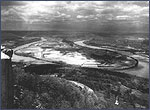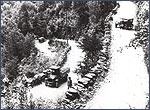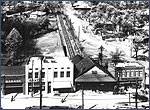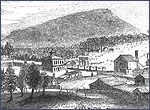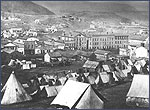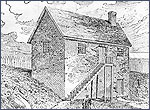Tennessee is the ancient Native American name given to a broad expanse of the country so rich with heritage that it is rivaled by none. Once the homeland of the Cherokee, Tennessee is bordered on the west by the Mississippi River and then races eastward to the mist-shrouded forests of the Great Smoky Mountains. The eastern portion of the state is truly beautiful; its mountains, waterfalls, and wildflowers have been the inspiration for many artists and poets throughout the centuries.
Interest in the region began in 1663 when the English King, Charles II, granted North Carolina a charter for land that spread to the Pacific Ocean. At that time, Tennessee was still a part of North Carolina, and the land was fully occupied by the Cherokee. A portion of that land, now Hamilton County, was a wilderness refuge of deep green forests and high, lofty mountain ranges.
During the Revolutionary War, the Cherokee sided with the British and fought against the American colonists because of the constant land manipulation, broken treaties, and oppression by the white settlers. After the war, the Americans insisted that the Cherokee had “given up” their land claims because of their stand during the war.
By 1783, politicians and land speculators had begun a new program of transferring land titles into private hands. North Carolina allocated millions of acres within Tennessee as military bonuses or generous bargains for surveyors. The southeast Native Americans began to rebel against this program, which resulted in many small field wars.
The Origins of Hamilton County
The origins of Hamilton County can be traced to the North Carolina land grants of the 1780s, which are some of the first real estate records in Hamilton County.
In 1784 the citizens of Washington, Green, and Sullivan counties formed a separate state they called Franklin, in honor of Benjamin Franklin. Franklin was established in what is now the Hamilton County region.
The creation of Hamilton County was crucial to the federal government because of the country’s hunger to acquire more land. Tribal land loss was especially devastating because the magnificent terrain had been such an abundant and necessary part of the Cherokees’ lives and heritage. When Tennessee gained statehood in 1796, three-fourths of the area was still Cherokee land, but the state continued to extend its borders.
Rather than assimilate the Native Americans into their culture, the white man’s expansion drove them from the region. The United States Constitution became a shining hope for the “new world,” a hope never before seen in other nations. The Constitution was a vision of little criticism or opposition and so ideal that it was not only embraced by the settlers but by the Native Americans as well. Its concepts of freedom gave new opportunities to oppressed people everywhere. Everywhere, that is, except for those native to the land.
In 1807, the United States government gave Robert Patterson permission to operate a mill for the benefit of the Native Americans. The Cherokee cooperated in the concession; otherwise Patterson would not have been permitted to live in the Cherokee Nation. Patterson was the first white man to establish a manufacturing business in the Hamilton County area and the first to bring his family with him.
Asahel Rawlings settled around 1810 in what was afterwards called Dallas. He and his family also had special permission to live in the Cherokee Nation. Patterson and Rawlings may be called the first citizens of Hamilton County. Hundreds of people followed their lead, moving into the area later to be called Hamilton County.
Hamilton County’s original borders were moved several times, first into Roane County and then again into Rhea County. Finally, Hamilton County (named in honor of Alexander Hamilton, Secretary of the Treasury in George Washington’s Cabinet) was erected by an Act of the General Assembly of the State of Tennessee on October 25, 1819. Tennessee at the time defined Hamilton County as being located “southwest of Rhea and south and east of Bledsoe and Marion counties.”
Rhea County has important bearings on the development of early Hamilton County. Before 1819, the Sale Creek Valley area was a part of the southern boundary of Rhea County. Pioneers in the Sale Creek Valley area were citizens of Rhea County, and some even became local officials in Rhea County. Then in 1819, new boundaries were drawn that made the Sale Creek Valley area a part of Hamilton County. Residents who once were citizens of Rhea County now became citizens of Hamilton County.
There were now 765 settlers within the new boundaries described for Hamilton County. Only the section north of the Tennessee River was included in the new county. The Cherokee Nation was south of the river and that land did not become part of the country until the Treaty of 1835.
The act of legislation enacting Hamilton County stated, “until otherwise prescribed by law, the court of common pleas and special sessions should be held at such place as might be designated by Charles Gamble, John Patterson, and William Lauderdale.” These three new commissioners were to select a site for the county seat and launch a new government. All three were early settlers who had previous experience as public servants.
These pioneers of the region designated the Walden Ridge home of Hasten Poe, known as Poe’s Tavern, as the county’s first courthouse and county seat. The sturdy, two-story log structure, located at Poe’s Cross Roads, now in the town of Soddy Daisy, served the traffic on the busy public road.
The commissioners directed their newly elected sheriff, Charles Gamble, to hold an election “on the first Thursday and Friday in March next and select field officers for the militia and designate the 64th Regiment attached to Seventh Brigade.” With the establishment of Hamilton County came the creation of a working judicial system.
In 1820, the Cherokee formed their own government and made innumerable attempts to keep their land. Nevertheless, President Andrew Jackson ordered all Native Americans to be “removed” to the west of the Mississippi River in 1830.
Despite the Cherokee’s attempts to work and live among the white man, ultimately they would be driven from the land they knew and loved. Local white residents were given the right to establish a local government, and the state of Tennessee authorized the citizens to provide law and order and establish a “seat of justice” to record deeds, obtain licenses, and levy taxes. Residents could vote immediately in local, state, and national elections.
Early Sheriffs and the Civil War
Before the formal, written Constitution was adopted, American colonists brought English common laws with them. The Crown of England designated shire-reeves (appointed for a one-year term) as the Crown’s representative of royal authority in a shire. Their responsibilities included keeping prisoners in “safe-custody, preparing the panel of jurors for the assizes, the execution of writs, and the sentence of death.” In addition, the sheriff acted as the presiding officer in parliamentary elections for the county and was required to attend to the judges at assizes.
Today, some of these same responsibilities of the early shire-reeve can be seen in the legal tradition held in the office of the sheriff . The sheriff is the highest ranking law enforcement officer in the county. His deputy forms a critical bond between community citizens and constitutional law.
Very little biographical information, and in some cases any written information, is available about the early sheriff s of Hamilton County. Most records from Hamilton County’s early sheriff s are slim because of the many moves of the county seat and the destruction of the courthouse. In addition, some sheriff s may have found it safer and less incriminating to “clear” their files upon leaving office.
The preservation of important records and documents was also hampered because of Union occupation in the area during the Civil War. Books were seized from the county register’s office and moved several times during the course of occupation. Book 1, which is supposed to contain many early historical accounts of the region, has never been found. Its loss has greatly contributed to blanks in the county’s history.
Before and during the Civil War, Hamilton County and the town of Chattanooga were radically opposed in their views regarding the war. Most of the town was for the Confederacy, while the majority of the county was Union in sentiment. Many families in the county were in sympathy with the Confederate cause, and some were divided in service and sympathy. This brought on bitterness and sorrow, and in some cases tragedy.
On September 9, 1863, during the term of Sheriff Robert G. Campbell, civil government ceased to exist as the first Union troops entered Chattanooga. After the crushing blow Confederate soldiers experienced at Missionary Ridge, many of the town’s original citizens left. The few remaining civilians began working to reestablish civil government.
Tennessee’s governor at that time, Andrew Johnson (who later became president after Lincoln’s assassination), urged military authorities to return civil control where possible. After President Abraham Lincoln issued his Proclamation of Amnesty and Reconstruction in December 1863, Johnson ordered elections for county officials to be held in March 1864. But voting requirements ordered by Johnson were not in keeping with Lincoln’s original intentions to kill the idea of secession.
The election resulted in a “serious farce” in Hamilton County, as well as the greater Tennessee region. Election restrictions were resented by Unionists and, of course, all Confederate sympathizers were excluded from ballot lists. Despite the fact that only 75 voters from the entire county went to the polls, eight civil offices were filled, including that of sheriff.
During this time, maintaining law and order created an extreme problem. Violence and theft were frequent in Hamilton County. City officials organized a volunteer police force to fight the outbreak of crime caused by a combination of poverty, refugee intake, returning Confederate soldiers, and restless Union troops anxious to return to their homes. Obviously, the Civil War and its aftermath were predominant issues in Hamilton County during the 1860s.
The 1870s brought new problems. The state debt weighed heavily upon the minds of Hamilton County citizens. County leaders were determined to recover financially and found themselves in alignment to join the Union as pressure from “economic carpetbaggers” was causing concern.
The term “carpetbagger” was used to describe Northern politicians and adventurers who came south to take advantage of unsettled conditions brought about the Civil War. This contemptuous word referred to their “light travel, frequently using bags fashioned from carpeting.”
Even though history has provided some brief biographical sketches of some of the earliest sheriffs, there is no extensive historic information in Hamilton County regarding the office of sheriff or his department. It was not until 1882, when Sheriff Cate and his deputy were murdered, that county law enforcement was routinely featured in news articles. Only then did the sheriff’s office begin to be publicized as the principal law enforcement agency in the county.
Much of what is known about early sheriffs comes from personal diaries and descriptions passed down from generation to generation.
For instance, former Hamilton County Judge Lewis Shepherd records a description of the county’s early courthouses in his personal memoirs. He describes the first as Poe’s Tavern. A large two-story log house, situated at the foot of Walden Ridge, Poe’s Tavern was designated as the court of “common pleas and special sessions” in 1819. The courts were held at the Poe home for several years and were then moved to the home of John Mitchell.
The courts remained at the Mitchell residence for only a short time before being moved to a crude structure established on the farm of Asahel Rawlings. A small town named Dallas developed around the court.
The third courthouse was built in Harrison and became the new county seat in 1840. Previously known as the Native American village of Van Town, Harrison was a rich, important region that was quickly populated when lands were opened for public entry. Residents built a substantial brick building for their court, and the county seat officially remained there until December 1870.
The Civil War interrupted normal judicial procedures for awhile. In 1862, Swim’s Jail, originally constructed to hold runaway slaves, was utilized by Confederates to house Union captives.
Until Chattanooga came under Union occupation, horrible stories came from the depths of the dungeon known as Swim’s Jail, where as many as 22 men would remain for weeks at a time. In dirty, rat infested, thirteen-by-thirteenfoot square rooms, the men would stay chained to one another in the inescapable hole of darkness and sweltering heat.
Post-Civil War and James County
After the Civil War, the county seat was changed from Harrison to Chattanooga in 1870. Harrison residents, enraged by the move, established a new county under Governor D.C. Senter from parts of Hamilton and Bradley counties. The act was passed on January 27, 1871, and James County, “affectionately known as Jim,” was established with its county seat located in the small railroad town of Ooltewah.
The new county immediately began having financial problems. In 1890, the state legislature moved to abolish James County but lacked the necessary two-thirds vote needed to do so. The courthouse burned down in 1913, and in 1919 James County finally went bankrupt. That same year the state legislature approved the territorial annexation of James County’s land and its population of 5,300, which was joined with Hamilton County. All of James County, however, was not returned to Hamilton County until 1957 when the legislative decision was formally amended.
The new county seat in Chattanooga was located in James Hall at the northeast corner of Market and Sixth streets; it served as a temporary courthouse until the fourth courthouse (and jail) in the old armory at Fourth and Market streets was designated as the court.
The fifth courthouse was built on its present site at a cost of $33,500. The lot opposite it, on Walnut Street, was purchased for the county jail for $2,300, and in 1881 the jail structure was erected. The courthouse was struck by lightning and burned on May 7, 1910, but the “Old Jail” remained. The sixth courthouse was rebuilt on the same site as the fifth and dedicated in 1913.
The End of an Era
The decade of the 90s brought the end of an era when, in 1994, Sheriff H. Q. Evatt made the decision to retire after two combined terms as sheriff , leaving a long legacy of transformation and accomplishments. During his 22 years as sheriff (1968- 1974 and 1978-1994), one of Evatt’s greatest legacies was the implementation of Civil Service, which provided job security for personnel for the first time in the history of the Hamilton County Sheriff's Office.
The era of Evatt’s administration also saw the creation of several new specialized divisions within the HCSO including the first School Resource Officers in the public schools, the establishment of the Traffic and Marine Patrol Divisions, the creation of the DUI Taskforce, and the expansion of investigative services.
The traditional duty weapon for the sheriff's office also changed in 1996 when the standard sidearm issued to law enforcement personnel transitioned from the Smith and Wesson 686 revolver chambered in the .38 cartridge to the semi-automatic Glock .40 caliber handgun. This change allowed deputies to utilize a semi-automatic handgun with a detachable magazine, which made the weapon capable of carrying 15 rounds as opposed to the six rounds held in the Smith and Wesson 686’s cylinder. Transitioning to the semi-automatic handgun also allowed deputies to carry additional magazines for added rounds.
Approaching the New Millennium
The law enforcement profession is one of continuous change and transformation. Each year, innovative technology, enhanced vehicles, and new training requirements and standards keep agencies in a constant state of evolution. The HCSO, like other large law enforcement agencies throughout the state, has not been impervious to change; rather the sheriff’s office has attempted to remain on the forefront of technology and embrace the opportunity to better serve our citizens.
The law enforcement profession experienced an important professional milestone in 1982 when the state of Tennessee adopted the national Peace Officer Standards and Training (P.O.S.T.). The adoption of P.O.S.T. required police departments and sheriff ’s offices in Tennessee to meet and comply with rigorous minimum standards and training requirements for officers, which in turn have resulted in a more professional and qualified level of law enforcement in Hamilton County and the State of Tennessee.
The Age of Technology Based Law Enforcement
The new millennium ushered in many technological advances and opportunities for the Hamilton County Sheriff’s Office. Developments in vehicle safety and radios, computers, and camera technology have led to better equipped personnel and more efficiency among divisions and inter-local law enforcement operations.
The early 2000s saw the installation of the first dash-mounted camera systems and laptops in patrol units, which greatly improved transparency and liability, and provided personnel the ability to offer video evidence and paperless reporting. In 2009, deputies received the first patrol rifles utilizing the AR-15 platform chambered in the .223/5.56 NATO round to combat the growing risk of active shooters and increased likelihood that suspects could utilize ballistic armor.
In 2015, the patrol fleet transitioned from the aged, small Chevrolet Impala to the larger, more versatile all-wheel-drive Ford SUV response vehicle. This transition responded to the growing need for more equipment storage and allowed law enforcement personnel to carry specialized response gear. The allwheel-drive vehicle also improved deputies’ ability to respond to emergencies in inclement weather and off-road terrain. This time also saw the introduction of the Dodge Durango for Criminal Investigations Division personnel. Like the Ford SUV response vehicle, the Dodge Durango affords detectives the ability to carry important gear and tools for various investigations and prolonged scene operations.
New Specialized Units
Like all law enforcement agencies, the Hamilton County Sheriff's Office has had to adapt through the years to incorporate new technology and meet the needs of our community. This includes the creation of specialty units to respond to various incidents and new-age threats, such as domestic terrorism and biological and chemical agents.
In 2003, HCSO’s Special Weapons and Tactics unit (S.W.A.T.) was created to respond to a growing number of threats in the community. The increase in incidents requiring a specialized response, such as those involving barricaded parties, hostage-type scenarios, active shooters, felony high-risk warrant services, and the threat of domestic terrorism demands specially trained personnel who are prepared to respond in a specific and safe operational manner. Prior to 2003, the HCSO utilized a Special Response Team (SRT) for operational needs and critical incidents. Each member of S.W.A.T is a highly trained and skilled law enforcement officer.
Beginning in the middle of 2000, the HCSO introduced its Sheriff's Underwater Search and Recovery Team (SURT) as part of the Criminal Investigations Division. The SURT Team is comprised of highly trained and equipped public safety divers. This team is capable of recovering any evidence up to mid-size vehicles and boats. The team can operate in any weather conditions and can deploy both a remote operated vehicle (ROV) and side-scan sonar technology to investigate threats and recover evidence.
In January 2019, the SURT Team responded to its greatest recovery and investigative challenge to date: the search and recovery of an airplane and passengers that had gone down in Lake Chickamauga in northern Hamilton County. The search and recovery efforts lasted over a week and demonstrated the professionalism and skilled capabilities of SURT divers.
The advent of unmanned aerial systems (drones) and sophisticated laser mapping equipment systems has brought a new level of accuracy and efficiency to a variety of situations such as search and rescue, evidence collection, crime scene investigation, surveillance operations, investigative practices, and the threat of domestic terrorism.
Large areas that would normally take personnel days to search can now be searched in hours or even minutes with drones. Utilizing Forward-Looking Infrared Cameras (FLIR) technology, drones are able to produce high quality video at night, which allows drones to capture video in all lighting situations by capturing a person’s body heat.
Achieving Professional Standards through Multiple Accreditations
On November 16, 2013, HCSO received one of the biggest professional milestones in its history when the agency was awarded accreditation by the prestigious Commission on Accreditation for Law Enforcement Agencies (CALEA), which certified that the agency had complied with 484 best-practice standards.
CALEA requires that agencies develop a comprehensive, well-thought-out, uniform set of written directives based on national best practices and standards to govern operations and administration.
In addition to CALEA accreditation, the HCSO’s Corrections Division has achieved national accreditation from both the American Correctional Association (ACA) and National Commission on Correctional Health Care (NCCHC) while maintaining state certification from the Tennessee Corrections Institute (TCI). Like CALEA, each of these accreditations and certifications requires extensive, well-thought-out policies and procedures in compliance with national and state standards and best practices.
As a result of meeting the high standards of CALEA, ACA, and NCCHC, the sheriff's office has now achieved the prestigious Triple Crown award from the National Sheriffs’ Association.
A Growing County
The new millennium not only brought advances in technology to the sheriff's office, but a surge in population growth in the unincorporated areas of Hamilton County. The areas of Highway 58, Birchwood, Ooltewah, Georgetown, Soddy-Daisy, and Sale Creek have seen unprecedented residential and commercial growth. In 1990, the federal census reported the population of Hamilton County at 285,536. By July 2018, the population of Hamilton County was 364,286, an increase of over 78,000 people.
As populations shifted from predominantly urban areas to suburban and rural areas, the HCSO has expanded its coverage areas to include new businesses, schools, and subdivisions. This includes the need for new school resource officers, additional patrol deputies, more corrections officers, and additional space for inmates, among other areas of internal growth and support services.
Hamilton County Economic Growth
Just as technology changes year to year, counties hope to experience consistent growth by demonstrating a healthy local economy, stable employment, safe neighborhoods, and a high quality of life for citizens. Hamilton County has been fortunate to see record growth in suburban areas in the unincorporated portions of the county as well as in the many municipalities in the county.
In 1993, the U.S. Department of Defense began disposing of properties in the southeastern United States that were no longer in use. One of these properties was the site of the historic Volunteer Army Ammunition Plant, which was established in the late 1930s to build munitions for the U.S. Army during World War II and had sat largely unused for decades. In February 1998, the City of Chattanooga and Hamilton County were approached about their interest in acquiring the site.
After negotiations, the site was acquired jointly by Hamilton County and the City of Chattanooga and plans were developed to use the majority of the site as an industrial megasite. State and local government leaders as well as Chattanooga Chamber of Commerce officials proposed a plan to utilize the megasite with hopes of attracting major manufacturing investments such as an automobile assembly plant and subsequent second- and third-tier suppliers. The site was officially named Enterprise South Industrial Park and would eventually contain 6,000 acres.
To support this endeavor, in 2006 the Tennessee Department of Transportation constructed a major interchange near the site, which allowed easy access to Interstate 75. This construction also included a connector road that led into the site for future manufacturing and transportation access.
In July 2008, local, state, and federal leaders, along with dignitaries and German business leaders, gathered to announce that Volkswagen had selected the site to build its new, multi-billion dollar automobile manufacturing plant. This unprecedented manufacturing investment would be joined later with the additional growth of various suppliers, third-party logistics carriers, and other support related original equipment manufacturing (OEM) enterprises.
The Volkswagen plant was completed in April 2011, and the first Passat rolled off the line on April 18, 2011.
In October 2010, another significant private sector investment was made in Enterprise South when CSX and Norfolk Southern Railroads invested $6.6 million to provide dual rail lines to support Volkswagen’s manufacturing needs.
To preserve the site’s wildlife and military history, 2,800 wooded acres were designated as a park for citizens to enjoy. Construction of the Enterprise South Nature Park began in 2006. To honor the historic military service of the site, three of the bunkers used as magazines from World War II were left intact. These bunkers were used to store explosives and munitions during the days when TNT was manufactured on the site. The park off ers miles of walking paths, bicycle paths, and off -road biking trails. In December 2010, the Enterprise South Nature Park was officially opened to the public.
The creation of Enterprise South Industrial Park is just one of hundreds of successful business ventures in Hamilton County that have helped to shape the strong, vibrant local economy. Thanks to the strong economy, educated workforce, and high quality of life, Hamilton County has become a hub for large employers such as Cigna, BlueCross BlueShield, Amazon, and numerous technology based start-up firms. In addition, Volkswagen’s decision to locate its new plant in Chattanooga brought numerous second- and third-tier suppliers to the community, employing hundreds of people to support the operations and logistical needs of the plant.
Hamilton County Experiences Mother Nature
No community is immune from experiencing Mother Nature. In recent memory, several notable weather-related incidents aff ected Hamilton County and caused significant damage to property or infrastructure, disruption of daily life, or in the worst case, loss of life. These weather-related events tested the limits of local first responders and emergency services.
Blizzard of 1993
From March 12 through March 13, 1993, a blizzard inundated the Tennessee Valley with several feet of snow and ice. Portions of Hamilton County experienced over 22 inches of snow and snow drifts over five feet. Some residents were without power for days, and in some cases weeks. As much of the HCSO patrol district lies in rural areas, icy roadways and widespread power outages plagued deputies and first responders attempting to assist those in need. To date, the Blizzard of 1993 was one of the worst snow storms to hit the Tennessee Valley and Hamilton County in recorded history.
The Flood of 2003
Beginning around midnight on May 5, 2003, a severe band of thunderstorms brought long periods of heavy rain to Hamilton County. Approximately 12 inches of rain fell before the system ended on May 8. As swollen lakes, streams, and tributaries drained into the Tennessee River, wide-scale flooding occurred throughout the county and the cities of Chattanooga and East Ridge. Some of the worst flooding occurred within Chattanooga near Rossville Boulevard and East 23rd Street.
Hundreds of people needed to be evacuated, and damage to private and public property was estimated to approach $20 million in Hamilton County alone. The flooding near 23rd Street covered cars and required water rescue teams to operate boats down Rossville Boulevard.
Three Years of Consistent Tornado Damage
During the years of 2010-2012, Hamilton County experienced significant damage when multiple tornadoes devastated areas of Apison, Birchwood, Hixson, Lake Chickamauga, Red Bank, Lookout Valley, and Sale Creek.
On October 26, 2010, a tornado touched down at Highway 153 and Access Road, causing damage at Lakeshore Terrace and destroying several mobile buildings used by construction contractors for the Chickamauga Dam expansion. The tornado traveled to the Lakeshore area, damaging several apartment complexes, then to Hixson before touching down in Red Bank near Ashland Terrace. Several reports were received of downed trees on homes and power lines, with one home having its roof removed by heavy winds. Fortunately, other than minor injuries due to a vehicle crash, no injuries or fatalities were reported.
The Apison Tornado of 2011
Many Hamilton County residents vividly remember April 27, 2011, as a frightening and horrific day in which they feared for their lives and safety.
On that day a major storm system generated tornadoes that aff ected the southeast United States over a two-day period. Local meteorologists and the National Weather Service warned government agencies and citizens to prepare for the very real probability of tornadoes. At 8:00 am, after numerous EF1 tornadoes touched down in Alabama causing severe damage and casualties, the Hamilton County Emergency Management Agency (HCEMA) officially opened the Emergency Operations Center (EOC) in preparation of the storm rolling towards Hamilton County.
At approximately 8:55 am, Chattanooga Fire Department personnel in Lookout Valley spotted a large funnel cloud near Lookout Mountain and sought shelter in the basement of Station #20. When the all clear was given, they emerged to find the area of Tiftonia and Lookout Valley devastated by what would later be categorized as an EF2 tornado with wind speeds upward of 130 mph. The tornado left a landscape of downed power lines and trees, destroyed homes, and overturned vehicles.
At approximately 9:04 am, an EF1 tornado appeared over the area of Ashland Terrace in Red Bank while two other EF1 tornados touched down over East Ridge and along North Hickory Valley Road near Harrison. Approximately 30 minutes later, a fourth EF1 tornado touched down near Birchwood. Each tornado caused widespread damage in its path and injuries and major property loss.
Later that afternoon, another EF1 tornado touched down in the Ooltewah area before moving northeast to Bradley County. At 3:30 pm, a tree fell on the home of Mai Crumley, killing her while her husband and nine-year-old son sought safety in a closet. Mrs. Crumley would be the first fatality in Hamilton County as a result of the tornados of April 27. Unfortunately, she would not be the last.
Throughout the afternoon and early evening, numerous tornadoes ranging from EF1 to EF5 devastated areas of the southeast, including Tennessee, Alabama, and Georgia. By 8:00 pm, the Electric Power Board (EPB) was reporting that over 100,000 customers were out of power, the most in its 72-year history.
Later that night, news reports announced that another round of powerful storms were likely to produce tornadoes and could aff ect Hamilton County. At 8:30 pm, with local emergency services personnel and law enforcement already over-extended, a major tornado hit the small rural community of Apison, claiming the lives of eight people, including four generations of one family. The tornado struck with ferocious wind speeds upwards of 190 mph and destroyed houses, uprooted trees, blew cars and mobile homes over, crushed buildings, killed livestock, and fl attened power and transmission lines. 39 More than 100 people were injured from the incident.
Throughout the night, tornadoes and high winds continued. Over 122 tornados struck the southern states and killed more than 300 people during the tragic and historic 15-hour tornado outbreak. In Tennessee alone, 53 tornadoes were reported to have touched down.
The April 27 tornado outbreak tested the community’s resilience and the strength and courage of local emergency services and law enforcement personnel. The Hamilton County 911 Communications District was flooded with calls for help from people all over Hamilton County needing assistance and reporting injured parties. Roadways were blocked by debris, hampering emergency services’ ability to respond to those who needed assistance.
Hamilton County Sheriff's Office deputies assisted with search and rescue operations, directed traffic and cleared roadways, checked rubble and debris for the injured, assisted with body recovery, and documented scenes where death or injuries had occurred. Local municipal and volunteer fire department personnel, along with volunteer search and rescue agencies, worked around the clock for days to comb through the debris searching for the injured.
The devastation and destruction caused by the April 27, 2011, tornadoes will go down in the annals of the agency’s history as one of the worst natural disasters personnel have ever had to respond to in the 200-year history of the Hamilton County Sheriff's Office.
Harrison Tornadoes of 2012
On the evening of Friday, March 2, 2012, Hamilton and Bradley counties experienced severe tornadoes for the second time in less than a year. The tornadoes destroyed more than 20 homes and injured 17 people in the greater Chattanooga area and were part of a massive storm system that wreaked havoc throughout Georgia, Alabama, and Tennessee.
According to the Tennessee Emergency Management Agency (TEMA), eight counties in Tennessee experienced tornadoes that day. In Hamilton County, the hardest hit areas occurred near Harrison Bay, Short Tail Spring Road, and Wolftever Road in Ooltewah. The Harrison tornadoes of 2012 once again tested the spirit of the community, and the response to these natural disasters demonstrated the resilience of citizens, first responders, and emergency personnel.
Terrorism Affects the Tennessee Valley
The morning of Thursday, July 16, 2015, began just like any other warm summer day. Several members of the Hamilton County Sheriff's Office Traffic Division found themselves awaiting the conclusion of a funeral service in order to assist with the procession they had been tasked to escort.
Shortly after the procession left the funeral home at approximately 10:30 am, reports to 911 came in that an active shooter had fired multiple rounds into the Armed Forces Recruiting Center on Lee Highway. The shooter, later identified as Muhammad Yousef Abdulazeez, fired approximately 30 to 40 shots inside the recruiting office from the parking lot, wounding one U.S. Marine.
With local law enforcement in pursuit, Abdulazeez drove approximately seven miles to the U.S. Naval Reserve Center on Amnicola Highway, where he crashed his vehicle through the front gate of the facility. Abdulazeez then began a shooting rampage inside and outside the facility, wounding numerous sailors and Marines and killing five individuals before being fatally shot by police.
Hamilton County Sheriff's Office Traffic Division personnel diverted from the funeral procession to respond to the Naval Reserve Center along with HCSO personnel from other divisions including patrol and criminal investigations. Traffic Investigators riding their motor units recalled hearing gunshots as they crossed the overpass responding to the Naval Reserve Center. HCSO Traffic personnel responding on motor units were only armed with their sidearm as they pulled into the parking lot of the Reserve Center.
During the shooting, Hamilton County Sheriff's Office personnel worked together with numerous responding law enforcement agencies to clear the facility and secure the perimeter.
Five people, excluding the gunman, died in the attack. Four U.S. Marines died at the scene and one U.S. Navy sailor died at a local hospital two days later. All of those killed were shot while at the U.S. Naval Reserve Center. During this attack, two other people were injured, Sergeant DeMonte Cheeley, a Marine recruiter who was shot in the leg, and Chattanooga Police Sergeant Dennis Pedigo Jr., who was shot in the ankle.
The July 16 terrorist attack left a tragic impact on Hamilton County as well as the nation. The day’s events shook the foundations of the community and left many to ask how an incident like this could happen. The event was investigated by the Federal Bureau of Investigation as well as the Naval Criminal Investigative Service (NCIS). After its conclusion, then FBI Director James Comey said the shootings were “Motivated by foreign terrorists organization propaganda.”
For weeks after the event, makeshift memorials were set up at the Armed Forces Recruiting Center and on Amnicola Highway in front of the U.S. Naval Reserve Center in honor of those killed and injured in the attack. Those killed during the terrorist attack were Marine Corp Sergeant Carson A. Holmquist, Navy Logistics Specialist Second Class Randall Smith, Marine Corps Gunnery Sergeant Thomas J. Sullivan, Marine Corps Lance Corporal Squire “Skip” Wells, and Marine Corp Staff Sergeant David A. Wyatt.
The Historic Bridge Plan Passes
On February 24, 2016, a long-awaited vote took place by the Hamilton County Commission to address a long-standing issue pertaining to the safety and retirement of certified law enforcement personnel. The Commissioners voted to enact the HCSO Bridge Plan after many years of discussion and review.
The Bridge Plan would allow certified law enforcement officers with 25 years of service to retire at age 55 and receive a monetary supplement for creditable service to “bridge” the gap between their retirement and Social Security until they reached age 62. Once the deputy reaches age 62, the bridge supplement would cease and they would receive both their regular pension and Social Security. Whether the deputy chooses to take advantage of the Bridge Plan prior to turning age 62 or not, it requires mandatory retirement at age 60. If a law enforcement officer holds the rank of sergeant or above, the mandatory retirement age increases to age 62.
There are many long-term benefits of enacting a Bridge Plan, including three key areas regarding officer morale, safety, and recruitment. A career in law enforcement is difficult and dangerous and the Bridge Plan allows officers to retire at an earlier age with dignity so as to avoid possible on-the-job injuries that could be more difficult to overcome at an advanced age.
Allowing an officer to retire and collect the same amount of retirement they would at age 62 with Social Security gives law enforcement personnel the opportunity to retire with peace of mind and hopefully in a better state of personal health.
The Bridge Plan also allows for more progression of personnel through the ranks by allowing more opportunity for advancement. As noted previously, prior to the Bridge Plan, law enforcement personnel would have to work until they were age 62 in order to collect their Social Security despite their health or physical condition.
Lastly, it serves as an important tool for recruitment, as interested, successful candidates will have the benefit of an early retirement if they choose. Younger law enforcement officers see early retirement as a strong benefit that increases job satisfaction and employment retention.
Although the commission voted on the Bridge Plan on February 24, 2016, the eff ective date of the resolution was to take place on August 1, 2016. In order to provide for a transition period, the resolution was deferred to July 1, 2018, for the mandatory age requirement to be enforced.
Hamilton County Struck Again by Powerful EF3 Tornado
On Easter Sunday, April 12, 2020, around 10:30 pm, a devastating tornado touched down near Camp Jordan in East Ridge and travelled through parts of East Brainerd including Shallowford Road, East Brainerd Road, Bill Reed Road, and Jenkins Road areas. This tornado, later determined to be an EF3, spanned nine miles long by 1500 yards wide, and destroyed homes and businesses within the cities of East Ridge and Chattanooga, and the unincorporated parts of Hamilton County. Ultimately, over 150 structures were damaged and over 60,000 people were left without power.
The tornado claimed the lives of two people in Hamilton County and injured dozens more. At least 14 people had to be transported to hospitals for injuries. Altogether, eight people were killed by this violent storm system that aff ected three states and numerous areas of southeast Tennessee.
For weeks, HCSO personnel assisted with security and traffic control in the affected areas as homeowners, contractors, and utility crews worked tirelessly to rebuild and restore utilities.
Looking to the Future
Despite the tremendous improvements and advances made during our extensive and proud 200-year history, it is evident the future of this agency and of the law enforcement profession will rely heavily on an educated police force utilizing the newest technologies and science.
Each year, new technology and improvements continue to change the face of modern law enforcement. Advancements in forensic science and computer-based modeling represent just a couple of the disciplines that continue to evolve, aiding law enforcement’s ability to solve crimes and change criminal behavior and activity.
The Hamilton County Sheriff's Office has a lengthy and honorable past and will continue to play a vital role in the safety and security of our county and our state. Our future is bright and the efforts of our people and the mission we serve will remain a shining beacon of law and order.
For over two centuries, the men and women of the Hamilton County Sheriff's Office have answered the call to protect our community and the rights of our citizens. Our legacy of service will endure and future generations will continue to proudly take up and wear the star of the Hamilton County Sheriff's Office.

